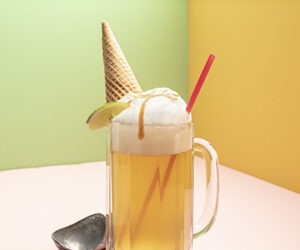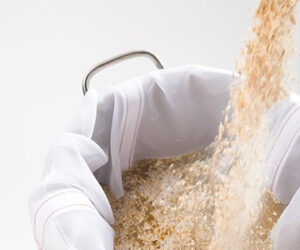Oktoberfest: Tips from the Pros
Brewer: Matt Greff, Arbor Brewing Company in Ann Arbor, MI
Our Oktoberfest is basically a 5-gallon (19-L) homebrew recipe that we scaled up to production level. In fact, most of the brews we make here started out as 5-gallon (19-L) recipes. It’s like a dream come true, being able to make my homebrews on a larger scale and sell them to the public. We’ve done quite well — just last fall, we doubled our brewing capacity.
I think an Oktoberfest should be medium-bodied, with some nice maltiness but not too sweet. There should be a hint of bitterness at the very finish. Some brewers tend to overdo the sweetness part of the beer, mostly by going too light on the finishing hops or using too much of a grain that brings out sweetness — Munich malt is an example. Our grist is meant to add malt texture without making an overly-sweet brew. The color of an Oktoberfest should be golden-reddish. The nose will be mostly malt, but with a hint of hop aroma.
Our procedure for brewing Oktoberfest is really straightforward. First, the malt bill consists of 55–60% German Pilsner malt. To contribute to the medium body and maltiness, we add 35% Munich 10 (Munich malt at 10 °L). Much more of this grain and we’d push the brew towards being too sweet. But, you want to use enough to get away from having a light-bodied brew. Finally, to round out the malt bill, plus give some caramel sweetness and color, we add caramel 20 (crystal malt at 20 °L).
We have always mashed-in at a strike temperature of 130 °F (54 °C) for 30 minutes, then added lots of hot water to get a conversion temperature at 154 °F (68 °C). Fact is, though, that we use highly-modified German grains. I’m sure we could get away with just doing a one-step infusion mash. However, this is the way we’ve always done it and we’re happy with the results! We boil the wort for two hours, which helps this brew a lot.
My choice of hops is German Tettnanger. The reason is simple: I love them. They are used in Jever Pilsner, my favorite German beer. I find they give the beer almost what I would call “saltiness.” It’s a bite at the end of the beer that I really enjoy. I also believe Tettnanger hops are more gentle, and not as in-your-face, as Hersbrucker.
Our yeast selection is Ayinger yeast, which is the same as the White Labs Bock Yeast (WLP833). We found this one to be the most flocculant, which is important to us because we don’t filter our beers.
Finally, we conduct primary fermentation at 55 °F (13 °C) for about two weeks. Then, we seal the tank and let CO2 build in the tank for natural conditioning. We crash the temperature to 35 °F (1.6 °C) and let it sit for at least one month. This recipe turns out a fine brew.
Brewer: Joe Karls, Hinterland Brewery in Green Bay, WI
I recommend the following grist percentages for an Oktoberfest style brew: 75% two-row pale malt as the base malt and 25% colored specialty malts, such as caramel and Munich malts.
In my Oktoberfest brew, I go beyond even this recommendation. I’m striving to achieve a product that has many malt layers. By malt layers, I mean creating a malt balance that spans the taste and mouthfeel spectrum — from the initial (first), to the mid-palate and finally to the finish of the brew. In my Octoberfest, I use six types of malt — Hugh Baird Marris Otter malt, Dingeman’s Munich malt, Dingeman’s Special B malt, crystal malt (20 °L), chocolate malt and black patent malt.
This technique, however, is more of an art than a science. Homebrewers need to experiment with their brewing techniques, their recipes and their systems to see if layering works for them. Often, typical homebrewing problems like high fermentation temperatures can ruin the best layering efforts. This can reduce the complexity of what might have been a very interesting brew. So, the rule of thumb should be to produce a clean brew first and then move on to complexity.
With today’s highly-modified malts, great beer in almost all styles can be achieved using the simple infusion technique. This is true for Oktoberfest style brews. That said, I have always used a temperature-controlled step mash process, although this is more out of habit than necessity. Many brewers us a step mash for brewing beers like this, but I wouldn’t refrain from brewing Oktoberfest if you only do infusion brews.
I recommend that homebrewers be experimental and creative. Use traditional teaching to guide you, but not to dictate your brewing efforts. Taste every beer with the mindset that you are not judging a competition, so don’t be arrogant and “judge” your results. Just keep an open mind and educate your palate to the enormous spectrum of taste sensations in your glass.
At Hinterland, we age our version of this brew in American Oak barrels for 12 days. Let me point out that my recipe suggestion of using six different malts is not overkill. My goal is to create a malty beer that is fully layered for color and mouthfeel.
Matt Gref’s Michigan Märzen-Oktoberfest
(5 gallons /19 L, all-grain)
O.G. = 1.050 F.G. = 1.012
ABV = 4.8% SRM = 7 IBU = 25
Ingredients
6.5 lbs. (2.9 kg) 2-row German Pilsner malt (1.8 °L)
3.5 lbs. (1.6 kg) German light Munich (10 °L)
0.5 oz. (14 g) crystal malt (20 °L)
4.5 AAU Tettnanger pellet hops (bittering) (1 oz./28 g of 4.5% alpha acids)
1.1 AAU Tettnanger pellet hops (bittering) (0.25 oz./7 g of 4.5% alpha acids)
1.1 AAU Tettnanger pellet hops (flavor) (0.25 oz./7 g of 4.5% alpha acids)
White Labs WLP833 (German Bock) yeast
Step-by-step
Mash in at a strike temperature of 130 °F (54 °C). Rest for 30 minutes then raise the mash to conversion temperature at 154 °F (68 °C). Hold for one hour and sparge at 172 °F (78 °C). Collect wort until the specific gravity falls below 1.008 or pH exceeds 5.8. Add water so you have a little over 6 gallons (23 L) of wort before the boil.
Boil the wort for two hours, adding hops at 120, 60 and 30 minutes remaining in the boil. After the boil, cool the wort with a wort chiller and aerate well.
Pitch the yeast at 65 °F (18 °C), but drop the temperature over the course of one week to 55 °F (13 °C). Hold at 55 °F (13 °C) until fermentation is complete — about two weeks. Rack and lager at 35 °F (1.6 °C). Lager for a minimum of one month, preferably longer.


